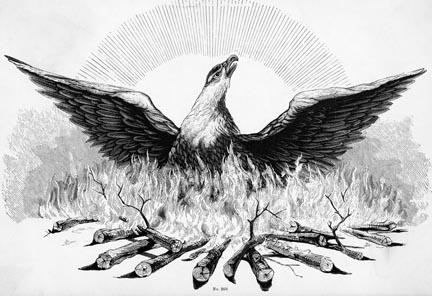What Us the Name of the Mythical Bird Who Dies and Rises Up Again Out of Its Flames?

The mythical Phoenix. (Bettman/Corbis photo)
Unraveling the legend of the phoenix is trickier than it might seem. The fabled bird is so thoroughly entwined in our civilization that most people take heard of it, but no i seems to know much most it—"Oh, aye, information technology's that bird that burns up and rises from the ashes, like in the Harry Potter books." Snazzy new Web sites and dusty library reference books don't offer much more than. One brief entry even said: "There is then much rich history about the phoenix, its story deserves a volume of its own."
Enter Joseph Nigg, perhaps the globe's sole phoenix scholar. He's writer of The Book of Fabulous Beasts: A Treasury of Writing from Ancient Times to the Nowadays—and is known as the Joseph Campbell of fantastical animals. Nigg is writing a volume about the phoenix and was just finishing chapter 19 of 20 when I called his home.
The Greeks rooted the tale of the phoenix in Western imagination more 2,500 years ago, simply its story exist
gan in ancient Egypt and Arabia. The fabled bird is said to live 500 years or more, and when the erstwhile bird is tired, it flies from Arabia to state in Heliopolis, Egypt, the "City of the Sun." In that location, information technology gathers cinnamon twigs and resin to build a nest of spices atop the Temple of the Sun. The lord's day ignites the nest and the one-time phoenix dies in flames. A new, young phoenix emerges from the ashes and wings back to Arabia to live some other life cycle. The bird'due south features have changed over the centuries, but most agree it's an eagle-like bird with shining cherry-red, gilded, and purple plumes.
The tale may have evolved from the Egyptian Benu, a sacred bird mentioned in the Book of the Expressionless that is associated with the sun god Ra and looks like a heron in hieroglyphics—or it may accept been mistaken for a cousin by Egyptologists overeager to make a connexion. The phoenix—a Greek give-and-take meaning "reddish-purple"—turns up showtime in a riddle past Hesiod. Themes of time and longevity suggest the bird was already well known to those trying to solve the riddle.
Although he lived two centuries later, the Greek historian Herodotus is credited with introducing the legend of the phoenix into Western culture after his travels in Arab republic of egypt. In his famous Histories (fifth century BCE), Herodotus tells of many new, fantastic beasts, including the crocodile, hippopotamus, and phoenix. Herodotus visits Heliopolis and talks to the temple priests: "They take another sacred bird called the phoenix, which I accept never seen, except in pictures. Indeed, it is a great rarity, even in Arab republic of egypt. They tell a story of what this bird does, which does not seem to me to be credible." This early on Greek version of the phoenix has no fire.
Similar all legends, details in tales of the phoenix vary. For instance, its long lifespan is sometimes 500 years, 540 years, or even 1,461 years (the Egyptian Sophic yr in astronomy). Some tales merits the phoenix has magical healing powers. Some other Greek historian, Pliny the Elder, scoffed at doctors who promoted the utilise of phoenix ashes to heal wounds. "He makes fun of it," Nigg says, and asks, "'How can you rely on a cure that is available only every 500 years?'"
Romans loved the phoenix. Their coins showed the emperor's head on 1 side and the phoenix on the other. "The phoenix represented Rome itself, the eternal nature of the empire, that it continues to return with each new emperor," Nigg says.
Merely even as Rome began its decline, the phoenix flourished in early on Christian Europe. Its message of rebirth and eternal life fit Christian themes, and popes like St. Cloudless (96 AD) used the phoenix to prove Jesus's resurrection. Monks included phoenixes in the bestiaries of the Middle Ages, making no stardom between God'due south wondrous creations—existent or imaginary. During the Renaissance, the phoenix was a popular emblem of royals like Elizabeth I and martyrs like Joan of Arc. "This is the greatest flow for the phoenix," according to Nigg. "Why not? With a word like 'renaissance,' a time
of rebirth and learning, you definitely have his fourth dimension."
Despite its potent Christian associations, the phoenix also appears briefly in Jewish tradition. The Talmud tells how the phoenix (Hol) was the only creature immune to stay in the Garden of Eden, considering information technology refused to eat the forbidden apple tree. God granted the bird immortality for its obedience.
Legendary birds around the earth are often linked to the phoenix, including what Nigg calls "phoenix counterparts" such equally the Persian Simurg, Chinese Feng Huang, and Russian firebird (Zhar-ptitsa). These birds arose from their ain local
folklore. Swarthmore Professor of Russian Sibelan Forrester says Slavic lore hosts ii mythical birds, the traditional firebird (star of Stravinsky'south ballet) and Finist the Bright Falcon, whose proper noun is derived from the Greek phoenix.
The Chinese phoenix Feng Huang (Ho-o in Japan) is a completely separate bird dating back at least seven,000 years. This celestial fowl became entwined with the Western phoenix through Scottish sinologist James Legge, who translated Chinese classics in the 1800s. His word choice persists, even though the Eastern bird has no fire, never dies (so is never reborn), and looks like a pheasant. Its very name represents the union of yin-yang, with "feng" being male and "huang" female. When paired with a dragon, the phoenix represents the empress and the dragon the emperor. This auspicious pairing too symbolizes good luck and harmony between husband and married woman.
Both the Eastern and Western phoenix legends begin in the murky days of prehistory. Some say the Chinese tale comes from afar memories of the extinct Asian ostrich. In Arab republic of egypt, a prehistoric flamingo may have inspired the tale, because rut waves rose f
rom the hot salt flats where it laid its eggs, perhaps suggesting a nest of fire.
Only like its legend, the phoenix enjoys a modern rebirth as a mascot, logo, and fairytale. Swarthmore is non alone in seeking a symbol of renewed life and hope after devastating fire. Cities including Atlanta; San Francisco; London; and institutions in Chicago and Coventry, England, take each adopted the phoenix. Its namesake, Phoenix, Ariz., reminds modern Americans that the city stands on the same site as a vanished Native American culture.
Why is phoenix lore and so indelible? "It'due south because of renewal," Nigg says; "information technology's promise for rebirth. I think it deals with hope."

Heather Shumaker '91
Before becoming a freelance writer two years agone, Heather Shumaker '91 was a conservationist working for a nonprofit land trust in Michigan. Female parent of 2 young boys, she has written for Parenting, Organic Gardening, and Pregnancy magazines; the Wisconsin Natural Resources Journal; and Traverse. Inspired by her enquiry for her current Bulletin article, she says, her well-nigh contempo Halloween costume was a phoenix.
Source: https://www.swarthmore.edu/bulletin/archive/wp/october-2008_the-phoenix-through-the-ages.html
0 Response to "What Us the Name of the Mythical Bird Who Dies and Rises Up Again Out of Its Flames?"
Postar um comentário